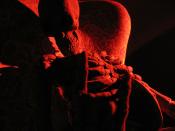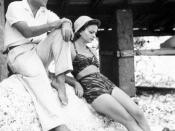In Elaine Scarry's The Body In Pain, and Elsa Morante's History, the lasting effects of war are suggested in two different, but similar ways. There are two main similarities involving the effects of war in these excerpts. One being the idea that war changes people in one form or another. The other being the idea of the effects of war reaching far and beyond the time the war took place. The main difference between the two pieces exists in the context the author utilizes these ideas. Morante chooses to use the psychological effects of war, while Scarry uses the physical effects. However, beyond their differences in context, the two authors succeed in insinuating one main point: the fact that even though a war has ended, it can never be forgotten.
In Scarry's excerpt from The Body In Pain, she hits upon the notion of the physical effects of war.
First she suggests that in times of peace and war, humans are affected in many different ways, but the duration of those affects are incomparable. The physical changes a person goes through in a time of peace such as a person "lifting their eyebrows"(Scarry112) while absorbing the political reality of war. On the other hand, by entering a war that person can be "participating in certain acts to the tearing out of his forehead, eyebrows, and eyes." (Scarry112) Scarry then goes on to discuss the effects of wartime, passing into peacetime. She uses examples such as " a grandfather whose distorted feet permanently memorialize the location and landing site of a piece of shrapnel in France.", and " a cousin whose damaged hip and permanent limp announce in each step the inflection of the word "Vietnam." (Scarry 113). Here Scarry is using examples of real people who have been permanently injured in a war, and who continue to suffer from those injuries. From there, Scarry uses cities such as Berlin and Paris to convey the lasting effects of war. For example; points out that Berlin's "bright, modern, architecturally "new" (Scarry 113) look is due to the fact that it had to be rebuilt from the damages of WWII. She also makes note of some city blocks in Berlin, some of them looking new or modern, and some of them still seem reminiscent of 1945. Between the comparison of actual physical damage done to humans, and to places and cities, Scarry has suggested that city blocks, although damaged in war, are far easier to repair than it is for the human soul itself.
In the excerpt from Morante's History, the damage done to a human, and her soul itself are used to display the lasting effects of war. Ida is a mother who has lost her son Nino in an altercation where he was involved in the transporting of stolen goods, such as guns. As an inspector points out, Nino may have been part of a post-war "pseuodo revolution", where unfortunately for Nino, the rules of war do not apply, he was breaking the law. After her son's death Ida is extremely troubled. At first she tries to deal with his death by holding in her cries and sorrow. However, this produces something inside of her she cannot escape. She is constantly plagued by the thoughts of his death, and various hallucinations of Nino, none which are pleasing, but rather terrifying. By using Ida, Morante creates a fictional story that can most likely be applied to many grief stricken parents who have lost their children in a war, or revolution. Morante also makes it clear that from Nino's death, a war has been created inside Ida herself. She now is constantly torn between feelings of guilt for his death, and when "the defendant Ida turns prosecutor" (Morante399) begins to blame Nino for his death. Towards the end of the excerpt Ida is no longer terrorized, by visions of Nino, but rather Nino has now become helpless and forever plagued by his "desire to live." (Morante400) The Body In Pain and History are two different ways of displaying the lasting effects of war. Morante's piece deals with the psychological effects, and Scarry's deals with the physical effects. However, similarities can be found because the effects of war are usually similar, in that they are usually not good. Scarry uses injured soldiers from war, and destroyed city blocks. Mornate uses a grieving mother tortured by her son's death. The character of Ida can relate to those wounded soldiers, and the city blocks. Even though she does not have a visible injury, she is still injured. Even though the Vietnam veterans limp that Scarry refers to as visible, Ida's now deranged mind is sort of an invisible limp. It hinders her from living a normal life, as Morante showed, she could not even raise her other son properly. (Morante 398) The city blocks that Scarry refers to as some being "strikingly today", and some "stopped at 1945", are similar to Ida in some ways, but in other ways incomparable. The blocks are similar because Ida's mind can be related to the blocks, some parts of her mind repaired, and some not. For instance, her visions of Nino not terrifying her anymore, is a step ahead is her recovery, can be seen as a block being repaired. However, the fact that she is still tortured by Nino's "desire for life" can be seen as a city block still "stopped at 1945", irreparable and still affected. On the other hand city blocks are not humans, human lives, and human souls are much harder to repair, both physically and psychologically. Conclusively, I feel both stories successfully convey the lasting horrors of war. Both articles make it clear through injured soldiers, city blocks, and grieving mothers, that war can never be forgotten. War has no time frame, even though a war ends, its existence is infinite.





